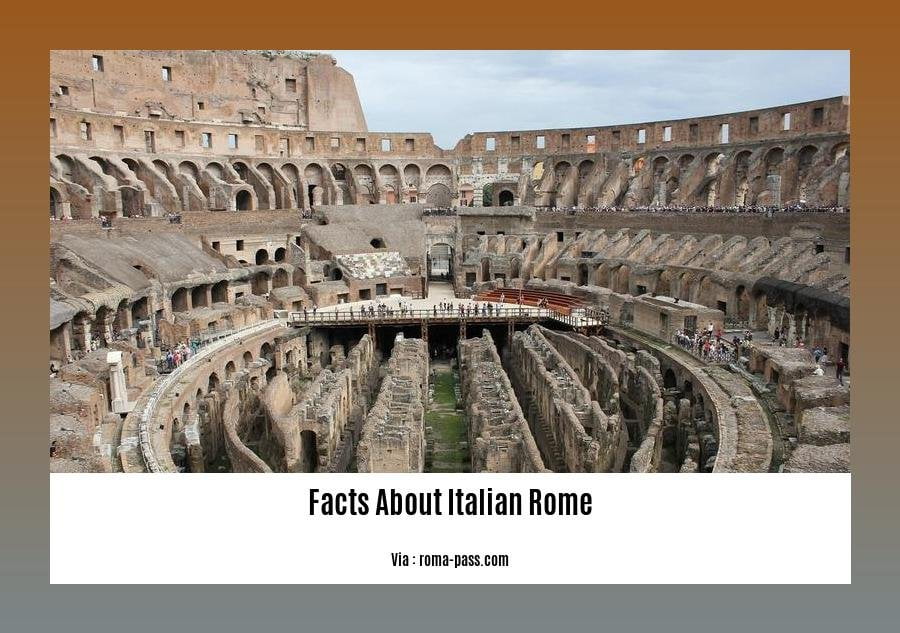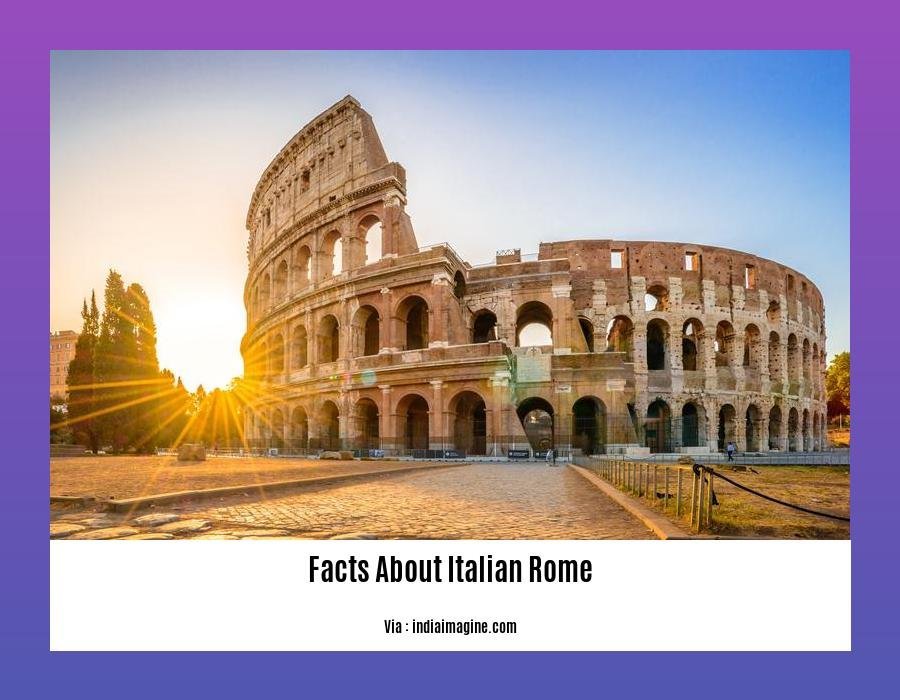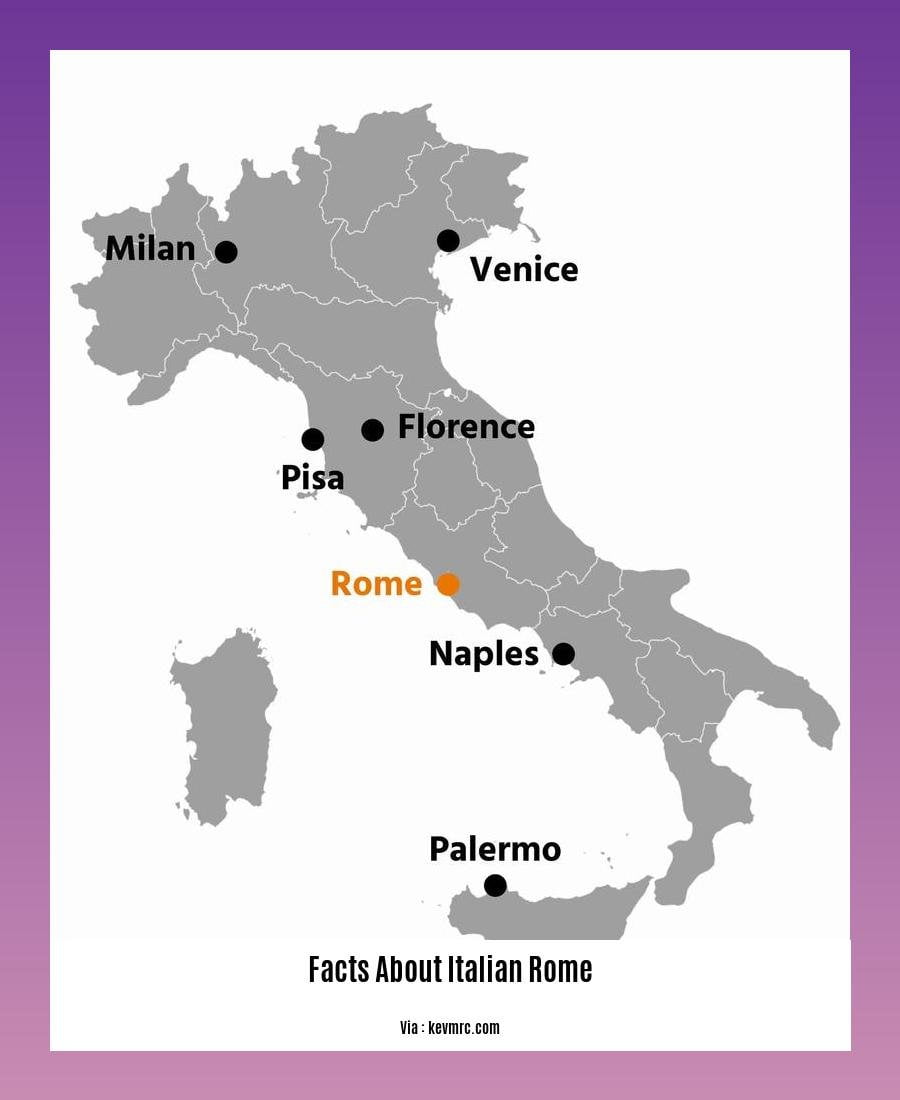Prepare to be enthralled as we delve into the captivating world of [[Facts about Italian Rome]: Unveiling the Secrets of the Eternal City]. Join us on an extraordinary journey through Rome’s rich history, uncovering hidden gems and intriguing stories that lie beneath the surface of this magnificent metropolis.
Key Takeaways:
- Rome’s history dates back to 753 BCE, making it older than modern-day Italy and serving as the capital city since 1871.
- Dubbed the “Caput Mundi” or “Capital of the World,” Rome stands as the most visited city in Italy.
- Over 2,000 fountains grace Rome’s streets and squares, with iconic landmarks like the Colosseum, Pantheon, Trevi Fountain, and Vatican City beckoning visitors.
- The nickname “Caput Mundi” mirrors Rome’s prominence throughout history.
- Rome boasts one of the world’s largest fountain concentrations, with over 2,000 adorning its urban landscape.
- Rome’s history spans an incredible 28 centuries, ranking among the oldest continuously inhabited cities globally.
- Vatican City, though within Rome’s boundaries, holds the status of an independent city-state and serves as the seat of the Roman Catholic Church.
Facts about Italian Rome

Rome, the Eternal City, is a living testament to the rich heritage and culture that defines Italy. From the grandiose architecture to the vibrant art, there’s a treasure trove of hidden stories and fascinating tidbits waiting to be discovered. Here are some captivating facts about Italian Rome that will ignite your curiosity:
Rome Is Older Than Italy Itself
Believe it or not, Rome predates the establishment of the Italian Republic by a whopping 2,500 years! This ancient city has witnessed the rise and fall of empires, shaped the course of Western civilization, and continues to captivate hearts with its timeless charm.
Caput Mundi: The Capital of the World
Rome proudly wears the title of “Caput Mundi,” meaning “Capital of the World.” Throughout history, it has been the epicenter of political, cultural, and religious influence, leaving an indelible mark on the global stage.
A City of a Thousand Fountains
Strolling through Rome, you’ll be greeted by the gentle sounds of water flowing from over 2,000 fountains scattered throughout the city. Each fountain tells a story, from the iconic Trevi Fountain, where tossing a coin ensures a return to Rome, to the elegant Fontana dei Quattro Fiumi, symbolizing the four major rivers of the world.
Rome’s Seven Hills
Legends and history intertwine in the story of Rome’s seven hills. While the city may appear to be built on only three hills—the Capitoline, Palatine, and Aventine—ancient Rome was actually founded on seven hills. These hills, mentioned in Virgil’s Aeneid, include the Caelian, Esquiline, Quirinal, and Viminal.
The Vatican City: A City Within a City
Within the heart of Rome lies Vatican City, the world’s smallest independent state and the spiritual center of the Roman Catholic Church. While geographically located within Rome, Vatican City is a sovereign entity, home to the Pope and the impressive St. Peter’s Basilica.
Want to know the fascinating history and culture of Greece? Check out our 10 facts about Greece article and explore the wonders of this ancient civilization.
Curious about Germany’s rich cultural heritage? Our Facts about Germany culture will take you on a journey through its traditions, festivals, and unique customs.
Discover the Cultural facts about France, a country renowned for its art, fashion, and gastronomy. Immerse yourself in its vibrant culture and diverse traditions through our comprehensive guide.
The Colosseum, an iconic amphitheater, was once used for gladiator fights and could accommodate up to 50,000 spectators.
In the heart of ancient Rome, nestled amidst the ruins of a once-glorious empire, stands the Colosseum, an architectural marvel that has withstood the relentless test of time. Its imposing presence serves as a testament to Rome’s rich history and the relentless pursuit of entertainment that defined its culture.
Key Takeaways:
The Colosseum, also known as the Flavian Amphitheater, was constructed between 70 AD and 80 AD under the reign of Emperor Vespasian and completed by his sons, Titus and Domitian.
With a capacity to accommodate 50,000 spectators, the Colosseum was the largest amphitheater ever built in the Roman Empire.
Its elliptical shape, measuring approximately 188 meters in length, 156 meters in width, and 57 meters in height, allowed for an unobstructed view of the spectacles from every seat.
The Colosseum’s iconic design featured 80 arched entrances, which allowed for the efficient movement of spectators, ensuring a smooth flow of traffic even during its most crowded events.
Beneath the arena, a complex network of underground chambers, tunnels, and elevators facilitated the smooth operation of the gladiatorial contests and other events, showcasing the Romans’ engineering prowess.
The Colosseum was primarily used for gladiatorial contests, which were brutal battles between trained fighters, often slaves or prisoners of war, who fought for their freedom or survival.
Other events held in the Colosseum included public executions, reenactments of famous battles, animal hunts, and elaborate dramas based on Roman mythology, all designed to entertain and awe the masses.
The Colosseum’s construction and maintenance were funded through various means, including taxes, imperial funds, and the spoils of war, reflecting the importance placed on entertainment and spectacle in Roman society.
The Colosseum’s bloody history came to an end in the 6th century AD, as the popularity of gladiatorial contests waned and the empire itself declined. It was repurposed for various uses over the centuries, including as a quarry for building materials, a shelter for animals, and even a temporary housing for earthquake victims.
Today, the Colosseum stands as a symbol of Rome’s enduring legacy, a reminder of the city’s ancient grandeur and the spectacles that once captivated its citizens. It is a UNESCO World Heritage Site and one of the most visited tourist attractions in the world, attracting millions of visitors each year who come to marvel at its architectural splendor and to connect with the echoes of history that reverberate within its crumbling walls.
References:
[1] https://www.nationalgeographic.org/encyclopedia/colosseum/
[2]
The Trevi Fountain: One of Rome’s Most Famous Fountains

The Trevi Fountain, one of Rome’s most famous fountains, is said to grant wishes to those who toss a coin into its waters.
The Trevi Fountain is widely renowned for its enchanting beauty and the legend surrounding its miraculous powers. Visitors flock to this Baroque masterpiece, eager to toss a coin into its waters and make a wish. But have you ever wondered about the fascinating stories and lesser-known facts that make this fountain so captivating? Let’s dive into the secrets of the Trevi Fountain!
History and Design
Nicola Salvi designed the Trevi Fountain, and Giuseppe Pannini completed it in 1762. The fountain is a testament to the grandeur of the Baroque era, with its elaborate sculptures and intricate details. Its central figure is Oceanus, the Roman god of the sea, standing triumphantly in his chariot pulled by two sea horses. The fountain’s facade is adorned with allegorical figures representing Abundance, Health, and Fame.
The Legend of the Wishing Coin
Legend has it that tossing a coin into the Trevi Fountain with your right hand over your left shoulder ensures a safe return to Rome. Toss a second coin for a romantic encounter, and a third for a Roman wedding. These coins, amounting to millions of euros annually, are collected and donated to various charities.
The Acqua Vergine Aqueduct
The Trevi Fountain is not just a work of art; it also serves a practical purpose. Its waters originate from the Acqua Vergine aqueduct, discovered by a young girl who led thirsty Roman soldiers to the spring. This aqueduct, built in 19 BC, is still in use today, supplying water to the Trevi Fountain and other parts of Rome.
Coin Tossing Etiquette
Tossing a coin into the fountain is a tradition, but there’s a proper way to do it. Stand with your back to the fountain, close your eyes, and make a wish. Toss the coin over your left shoulder using your right hand. If you follow these steps, your wish may just come true!
Trevi Fountain Trivia
- The Trevi Fountain has been featured in numerous films, including “La Dolce Vita” and “Roman Holiday.”
- Every night, the fountain is drained and cleaned, and the coins are collected.
- The Trevi Fountain underwent a major restoration in 1988 to remove discoloration caused by smog and pollution.
- The fountain was once used as a public laundry, where Romans would wash their clothes in its waters.
- The Trevi Fountain’s water is not drinkable due to the presence of coins and other debris.
Key Takeaways:
- The Trevi Fountain is a Baroque masterpiece designed by Nicola Salvi and completed by Giuseppe Pannini in 1762.
- Legend says that tossing a coin into the fountain with your right hand over your left shoulder ensures a safe return to Rome.
- The fountain’s waters originate from the Acqua Vergine aqueduct, discovered by a young girl who led thirsty Roman soldiers to the spring.
- The Trevi Fountain has appeared in numerous films and underwent a major restoration in 1988.
- The fountain was used as a public laundry in the past, and its waters are not drinkable due to the presence of coins and debris.
Sources:
- Britannica
- Travel and Leisure
Rome is home to many famous piazzas, such as the Piazza Navona, the Piazza di Spagna, and the Piazza del Campidoglio, each with its own unique history and architecture.
The public open space known as Piazza Navona was built on the site of the Stadium of Domitian, which was constructed in the 1st century AD. After the Western Roman Empire fell, the space was quarried for building materials and was left in ruins. The Piazza Navona was transformed into a public market in the 15th century, and later, during the reign of Pope Innocent X, it became a significant example of Baroque Roman architecture and art.
The Fontana dei Quattro Fiumi (Fountain of the Four Rivers), created by Gian Lorenzo Bernini, the church of Sant’Agnese in Agone, and the Palazzo Pamphili, designed by Girolamo Rainaldi, are noteworthy sculptural works that grace the piazza. Two more fountains are in the piazza: the Fontana del Moro with Tritons by Giacomo della Porta and the Fontana del Nettuno with a Neptune statue and sea animals by Antonio della Bitta.
The Piazza di Spagna is another well-known square in Rome. It was created in the 18th century and is home to the famous Spanish Steps, which link the square to the Pincian Hill. The square’s name comes from the Spanish Embassy, which has been there since the 17th century.
Piazza del Campidoglio is another stunning square located on the Capitoline Hill. Michelangelo designed it, and it is home to the Palazzo Senatorio, Rome’s city hall, the Palazzo dei Conservatori, and the Palazzo Nuovo.
Key Takeaways:
Rome’s well-known piazzas include the Piazza Navona, Piazza di Spagna, and Piazza del Campidoglio.
The Piazza Navona originated as the Stadium of Domitian, underwent repurposing as a public market, and evolved into a Baroque masterpiece under Pope Innocent X.
Bernini’s Fontana dei Quattro Fiumi, Sant’Agnese in Agone church, and Palazzo Pamphili are all found in Piazza Navona.
The Piazza di Spagna, created in the 1700s, features the iconic Spanish Steps connecting the square to the Pincian Hill.
Michelangelo created the Piazza del Campidoglio, located on the Capitoline Hill, and it houses key structures like the Palazzo Senatorio, Palazzo dei Conservatori, and Palazzo Nuovo.
References:
FAQ
Q1: When was Rome founded, and how does its age compare to the Republic of Italy?
A1: Rome’s history stretches back to 753 BCE, predating the Republic of Italy by an impressive 2,500 years. It officially became the capital city of Italy in 1871.
Q2: Why is Rome called “Caput Mundi,” and what is its significance?
A2: Rome’s title, “Caput Mundi,” translates to “Capital of the World,” reflecting its historical importance and its status as the most visited city in Italy.
Q3: What unique feature sets Rome apart in terms of its water features?
A3: Rome boasts an impressive collection of over 2,000 fountains scattered throughout the city, contributing to its distinct character and charm.
Q4: What are some of the iconic landmarks that draw visitors to Rome?
A4: Rome is renowned for its iconic landmarks, including the Colosseum, the Pantheon, the Trevi Fountain, and Vatican City, which, despite being a separate city-state, lies within Rome’s boundaries.
Q5: Is there a specific tradition associated with the Trevi Fountain?
A5: Yes, the Trevi Fountain is associated with a popular tradition where visitors toss coins into the fountain. According to legend, tossing one coin guarantees a safe return to Rome, the second brings romance, and the third ensures a Roman wedding.
















